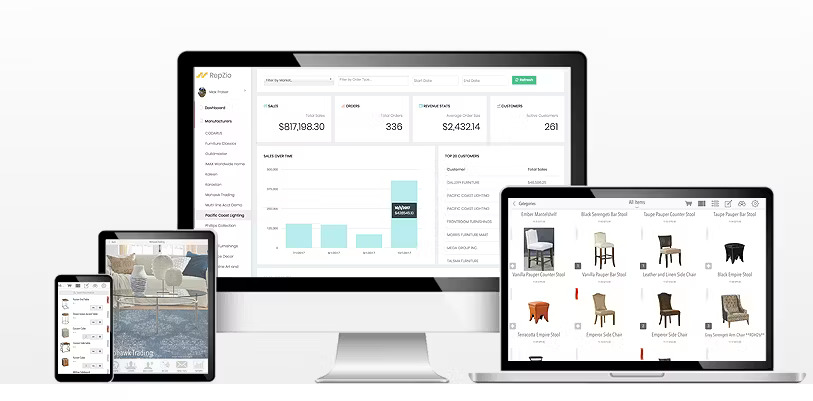Repzio is the top B2B eCommerce app 2024
Repzio has quickly become a cornerstone for businesses looking to thrive in the competitive B2B eCommerce sector, particularly noted for its mobile sales capabilities. Its influence has expanded across numerous industries, allowing businesses to leverage its innovative features to enhance operational efficiency and customer engagement.
This blog will provide a detailed guide on setting up your business with Repzio, focusing on how to maximize its B2B eCommerce platform to improve sales processes and customer interaction.
Getting Started with Repzio

Understanding Why Repzio Is the Top B2B eCommerce App 2024
Repzio’s platform is designed to empower businesses with tools for mobile sales management, offering extensive exposure to a targeted business audience. Key to setting up your operations with Repzio includes:
Some general requirements include:
- A detailed setup process tailored to your business needs.
- Compliance with Repzio’s user-friendly guidelines.
Setting Up Your Business on Repzio

To kickstart your business with Repzio, follow these steps:
Step 1: Register for an Account
- Visit the Repzio Website: Navigate to the Repzio site and locate the sign-up or registration section.
- Enter Business Information: Fill in your business details, including your company name, industry, and contact information.
- Create a Login: Set up your username and password. Make sure to choose a strong password for security purposes.
Step 2: Verification of Business Details
- Confirm Email Address: You will receive an email to the address you provided. Click the verification link to confirm your email.
- Provide Additional Documentation: Depending on your business type and industry, you may need to submit additional documentation to verify your business.
Step 3: Setting Up Your Profile
- Log In to Your Account: Once your email is verified, log into your Repzio account.
- Complete Your Profile: Fill out your profile information, including business hours, address, and other contact details.
A quick video about RepZio
Navigating Through Repzio’s Features
Step 1: Adding Products
- Access Product Management: Navigate to the product management area in your account dashboard.
- Upload Product Details: Enter details about the products you wish to sell, including descriptions, pricing, and inventory levels.
- Add High-Quality Images: Upload clear and high-resolution images of your products to enhance their presentation on the platform.
Step 2: Configure Settings
- Payment Options: Set up your preferred payment methods and terms.
- Shipping Configurations: Define your shipping rules and options, including carriers and rates.
Step 3: Integration with Other Systems
- ERP/CRM Integration: If you use ERP or CRM systems, integrate them with Repzio to streamline data flow and maintain consistency across platforms.
- API Access: Configure API settings if you plan to use Repzio’s API for custom integrations or third-party applications.
Step 4: Launch Your B2B eCommerce Platform
- Preview Your Setup: Review all settings and product listings to ensure everything is set up correctly.
- Go Live: Once satisfied, activate your account to go live and start conducting transactions.
Dataautomation: Repzio’s Integration Partner
Integrating Repzio with other eCommerce platforms and fulfillment services can significantly enhance the efficiency of your sales and distribution processes. DataAutomation offers custom integration solutions that bridge the gap between Repzio and various third-party platforms, ensuring seamless data flow and streamlined operations. Here’s how you can leverage DataAutomation to connect Repzio with fulfillment platforms or other eCommerce stores:
If you are new to API calls check out Understanding API Calls for Beginners: A BlogVenture
Understanding the Need for Integration
Before setting up any integration, it’s crucial to identify the specific needs of your business. Whether it’s syncing inventory levels, automating order processing, or consolidating customer data, understanding these requirements will guide the development of an effective integration strategy.
Benefits of Custom Integrations
- Streamlined Order Processing: Connect Repzio to fulfillment platforms such as ShipStation, or a custom warehouse management system to automate the order fulfillment process. This reduces manual intervention and speeds up order processing.
- Keep Track of your Customers: Connect repzio with you other storefront like Shopify and track customer information.
- Inventory Management: Connect Repzio with Katana to get updates on inventory across both your retail and MRP channels.
Below are some of the API endpoints we can tailor to your shops specific needs.

Click HERE for a more detailed description of each API endpoint
Step-by-Step Guide to Setting Up Integrations
We use a web based PHP framework for all of our integrations so if you wanna learn how we do our custom integrations take a look at Custom eCommerce Software Integration: The Power of STEPS
Wrapping up
Repzio’s suite of B2B eCommerce solutions in 2024 offers compelling advantages for businesses looking to enhance their sales operations and customer service.
With ongoing advancements and a strong focus on integration and usability, Repzio remains a top choice for companies across various industries. Find out for yourself why Repzio is the top B2B eCommerce app 2024!
If you want to follow more blogs check out the links below! We also have a free E-book that gives greater detail on the technical aspects of Data Integration!

“Taking the busyness out of business“
OUR SOCIALS
A REST API (Representational State Transfer Application Programming Interface)

Free E-book
Check out our free E-book for more info below!
A REST API (Representational State Transfer Application Programming Interface)
More Blog Content!
- Time Saving eCommerce Hack 2025Wrapping Up Our 2024 Year Time Saving eCommerce Hack 2025 Whether you’re running an eCommerce store, managing inventory, or handling complex workflows, the systems… Read more: Time Saving eCommerce Hack 2025
- Out of the Box Versus Custom IntegrationWrapping Up Our 2024 Year Out of the Box Versus Custom Integration Integration is key to keeping your business operations smooth and efficient. Whether… Read more: Out of the Box Versus Custom Integration
- Wrapping Up Our 2024 YearWishing You a Joyful Holiday Season from DataAutomation…


Recent Comments